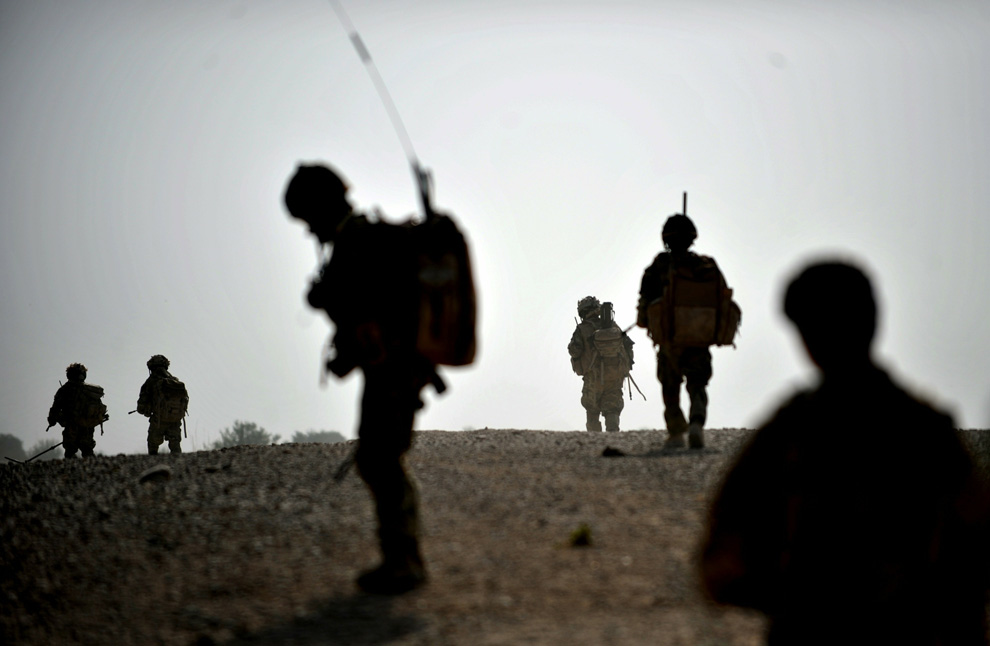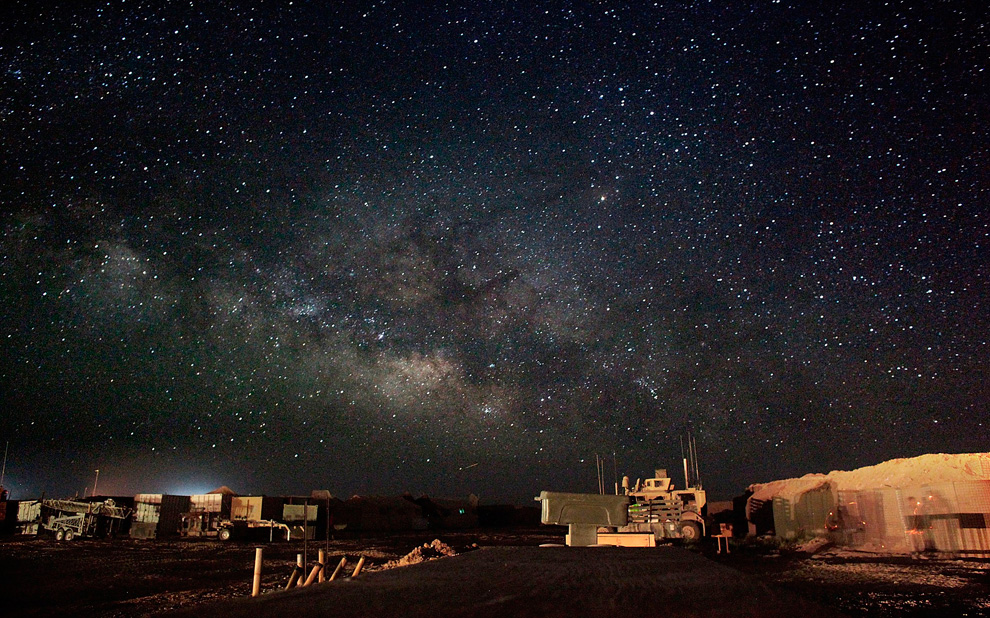The war in Afghanistan is not only a difficult military mission, it’s also a hard war to report on as well. And for the same reason: you have a modern army trying to subdue guerrilla fighters in a desolate land for no clear political purpose. The deployment of heavily equipped troops provides continual demonstration of enormous organizational and technological power, but with no identifiable enemies, territorial objectives, or sound strategic rationale the sense of things seems to drain away into the vast, almost lunar terrain. In these conditions, some photographers have managed to tap into mythic visions.

This photograph of troops on patrol was captioned to report that they are soldiers of the Royal Gurkha Rifles and Afghan National Police on patrol in Helmand province. That information tells you very little, however, and not enough to understand either the image or the war. Instead of reporting anything of note, the image evokes the mythic theme that war is eternal, and like other forms of eternity, a place where something elemental about moral life is revealed.
The patrol is moving out, two by two, across featureless terrain into some unseen, unknown future. One figure is stopped for a moment, and the profile allows us to see the burden he carries. Although he is equipped with a radio, he seems caught in silence, as are the others, their thoughts to themselves while everything else is reduced to being silhouettes. We don’t know where they are going, but in the myth it doesn’t matter. The long grey line continues forever, and they are simply carrying the load for their brief time. They walk through history into the unknown, as good soldiers always do and always will, ennobled by their simple devotion to duty.
Like I said, it’s a myth. I won’t deny it entirely, but I will note that it can expand into full sentimentality because there is so little in its way, and because mythic significance becomes especially appealing when no other, more pragmatic rationale is available. Whatever the photographer’s intention, something deep has been evoked by this image. What could be a parable of military activity without purpose evokes instead a sense that war is, if not an end in itself, something close to that.
Myths are used to make sense of large forces that exceed understanding. Mythic allusions may be particularly available in images of Afghanistan because there is a deep need to make sense of something that is becoming increasingly senseless. It has dawned on me that I now have several posts that identify various mythic projections infiltrating the optical unconscious: how the war is a form of extreme sport, or Afghanistan a new frontier. In each case, media culture digs into its storehouse to put up images that imply some otherworldly yet familiar narrative.
Maybe it’s just me, but I think the image above does double duty in this regard, as it also could be a scene from a sci-fi movie where the heroes head out from their craft to explore a dry, unforgiving planet. And so you can imagine my reaction when I saw this photograph:

This photo of the night sky over Camp Hansen in Helmand province is a stunning image of the firmament, so much so that I can feel the pull to go there and see the heavens so close, bright, vast, and deep. But I see something else as well: another mythic vision, this time from science fiction. Camp Hansen could be perched on some distant planet, a small outpost of humanity now flung across the stars. Across the stars, but still at war.
Photographs by Bay Ismoyo/AFP-Getty Images and Hyunsoo Leo Kim/AP/The Virginian-Pilot, thanks to The Big Picture.
Fascinating comments on a subject very close to my heart- the mythic vision of the military. I’m currently researching my PhD in this and really liked your interpretation of these images (the second one in particular).
Interesting take on the photo of troops headed out on patrol and certainly the concept of the mythic vision of the military is timely. However, the point of view, selective focus and the individual soldiers in silohuette remind me of the small plastic toy soldiers I played with as a child (I even photographed them… Ha!) The photo reminds me of those small soldiers I set out in formation in my sandbox or around my back yard. So, here I am viewing the photo and waiting for the hand of a 7 year-old boy to reach down and pick up one or more of the soldiers and place them somewhere else in the sandbox then, maybe, take another picture with his Brownie camera. It all speaks to the larger “human” forces that consider the troops to be pawns in the large scheme of international power. The troops in the photo are “frozen” in time and in their locations just waiting for the hand of a larger power move them to another position in the sandbox or gather them all up ending the game or… just leave those troops in their positions there in the sandbox forgotten as the child moves on to another interest.
Thank you for your thought-provoking ideas.
Well, I never took photos of my toy soldiers but I played with them just the same and your point is very well taken. As I look closer at the images the silhouettes have something of a plastic quality to them that make them somewhat less than human and thus accents the sense of Sartre’s “No Exit.” Indeed, this could be a scene from an episode of The Twilight Zone.
I agree about the image resembling a lunar landscape. The profile position of the soldier, with his bulky boots, square backpack and tall antenna, looks remarkably similar to images of the lunar landing. The grainy and blurred foreground and shadow almost make it appear that this soldier is levitating in a slow-motion, low-gravity moon-walk.
But this image took on a different, darker meaning once I read the caption. This image portrays Afghan soldiers on patrol in Helmand province with British soldiers, more specifically, members of the Royal Gurkha Rifles, an elite unit in the British Army. This post was made on the same day that an Afghan soldier turned on his trusting allies and killed three Gurkha riflemen by throwing a grenade into their sleeping quarters.
In this context, I interpreted this image to show the blurring of lines that always seem to occur during war, especially one fought against a guerrilla element that blends in with the civilian population. Who is an ally? Who is the enemy? In this photo, all the soldiers are silhouetted, making it impossible to see who these figures actually are. There are no identifiable faces or uniforms.
Perhaps most haunting is the figure in the right-foreground. He is the most blurry of all the men. He appears further back, distanced from the other soldiers, though he seems to be looking in their direction. His arm is bent, as if he is holding something in his hand. Having just read about the traitorous attack in Helmand, I couldn’t help but wonder, who is that person? What is he thinking? Is he a friend or foe? The soldiers in front are proceeding on patrol with their backs to him, trusting that he won’t attack them. Should they be so trusting?
In most cases, the Afghan soldiers are cooperating with ISAF troops, but on several occasions (at least three in the past two years), they have turned on their comrades. Army investigators, still searching for the assailant, are looking into various explanations for the attack. One possible reason was that the man was sympathetic to the Taliban; another was that the Taliban had kidnapped the man’s family, and forced him to carry out the grenade assault. The answer most likely changes how we view the perpetrator and his motives.
Given these examples of traitorous actions, it would be easy for some to say that the Afghan soldiers can’t be trusted. But in other cases, the attacks have come from within our own ranks, as was the case of Maj. Nidal Malik Hasan’s deadly rampage at Fort Hood, or Sgt. John Russell’s killing of five fellow U.S. soldiers at a stress clinic in Iraq last year.
With each of these tragedies, the trust that is so vital to the military and critical for our international missions is eroded, making success in Afghanistan, however you define it, harder to achieve.
In this conflict, as in so many others, the line between good and evil, allies and enemies is often unclear, much like the blurry shape in the foreground of this photo.
Robin (and Rich): Thanks for the additional reading of the image, which is proving to be even more evocative than I had imagined.
[…] blog, which has some interesting photography, particularly about afghanistan. to wit: Mythic Visions in Afghanistan | NO CAPTION NEEDED and this guardian just released this 15 minute clip from sean smith, someone about whom i know […]
[…] his recent post Mythic Vision in Afghanistan, Robert Hariman writes that in the face of “enormous organizational and technological […]